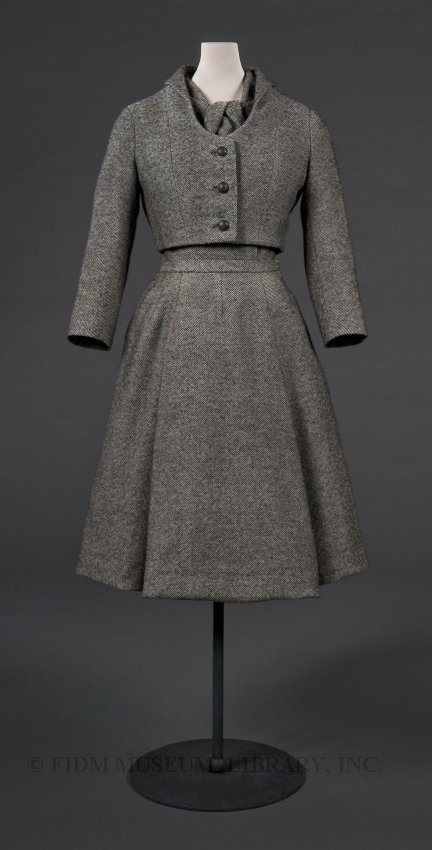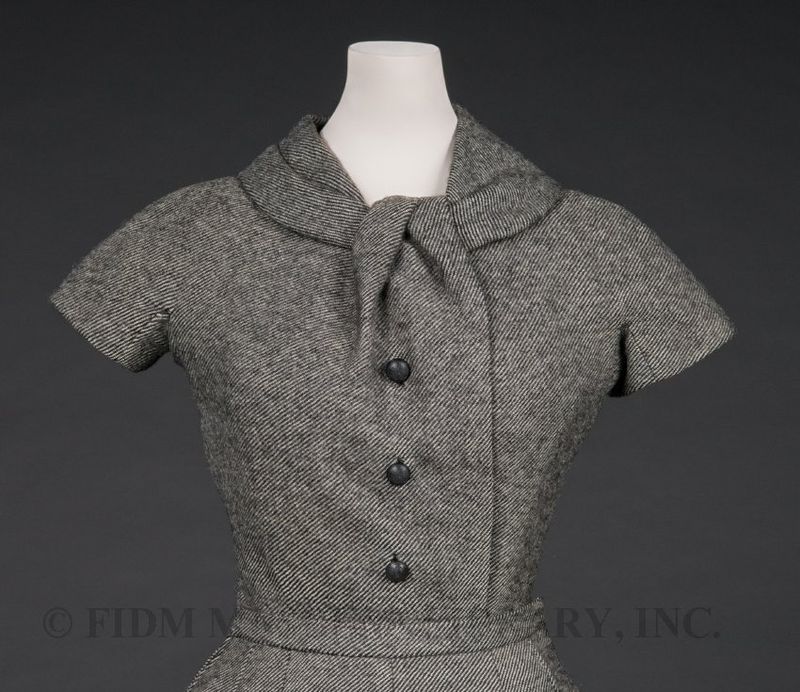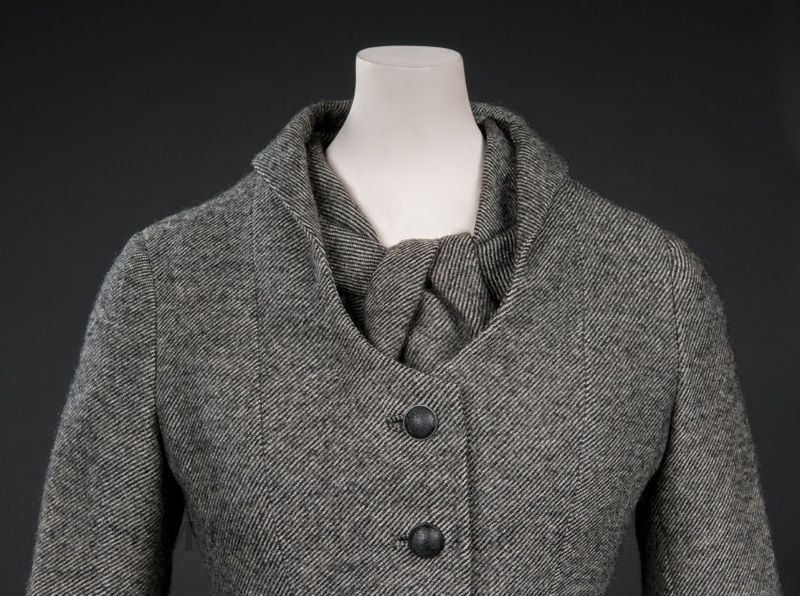Virevolte suit, Christian Dior, Autumn/Winter 1955
One of the most celebrated figures in the history of fashion, Christian Dior's reputation was founded on the New Look. Introduced in 1947, the New Look silhouette presented an idealized vision of the female body: soft, sloped shoulders and defined waist accented with long, full skirts. Called Corolle (petal) in French, the collection was both a reaction to the material deprivations of World War II and an expression of Dior's romantic, yet precise and sophisticated, take on femininity. This nostalgic romanticism was most openly expressed in Dior's cocktail and evening wear, especially in the petal-like skirts of Dior's Junon evening gown.
If Dior's evening wear was extravagant and flowery, his daywear was the opposite. In black, navy or gray, Dior's daytime suits were almost austere in their simplicity. Precisely cut and tailored, they demonstrated Dior's ability to translate menswear into the feminine idiom. In the wool twill suit pictured below, Dior presented a version of the masculine suit softened only by the rounded neckline of the jacket. Dior even went so far as to mimic the look of a neck-tie by tucking and pleating the fabric of the bodice to create a trompe l'oeil knot at the collar. Despite its serious appearance, this suit has a surprisingly lighthearted name: Virevolte. A French verb meaning to dance or twirl around, it suggests that Dior's romanticism was at play in even his most austere designs.

"Virevolte" 3-piece suit
Christian Dior
Fall/Winter 1955
Black and white wool twill
Gift of Mrs. Herbert Lawrence
81.443.1A-C
According to designer Geoffrey Beene, "Dior often seemed to lose interest in a dress after he worked his way down to the waistline."1 While this is probably an oversimplification, it is true that Dior's designs often move the eye to the upper body. This was especially true for Dior's Fall/Winter 1955 collection, La Ligne Y, or the Y-line. Dior frequently used letters to name collections, always choosing a letter that resembled the silhouette represented in the collection. The Y-line focused on the upper body, with short bolero jackets and large collars or stoles bringing attention to the neck and shoulders. In Dior's interpretation of the letter, the shoulders become the the outer points of the Y. A more literal interpretation of the Y-shape is seen in the deep neckline and inverted skirt pleats of the Ecarlate cocktail dress. Our wool twill suit features both elements of the Y-line: neck and collar interest and inverted pleats hidden in the skirt.
 81.443.1A-C Without bolero jacket
81.443.1A-C Without bolero jacket
Though he chose a thick wool twill for Virevolte, Dior's seamstresses used several tricks to create a smooth, unbulky waistline. The lower portion of the bodice (tucked into the skirt in the photo above) is a peplum made from lightweight gray silk. Its length allows the bodice to stay securely tucked into the skirt while also reducing bulk. The deep, symmetrical inverted pleats at front and back of the skirt were also trimmed, again to reduce the bulk of the wool twill. Carefully spaced vertical darts also help ensure a precise fit at the waist and hips.
Sewing expert Claire Shaeffer featured our Virevolte suit in the latest edition of Couture Sewing Techniques (2011). In this updated version of her classic book, Shaeffer provides detailed information on sewing techniques used in the haute couture. Focusing on the great names of twentieth-century fashion, including Yves Saint Laurent, Chanel and Christian Dior, it's a fascinating peak into the nitty gritty aspects of creating flawless designs.
 81.443.1A-C In this detail shot, the menswear effect of the neckline is very obvious.
81.443.1A-C In this detail shot, the menswear effect of the neckline is very obvious.
1 Martin, Richard and Harold Koda. Christian Dior. New York: Metropolitan Museum of Art. 1996: 161.